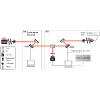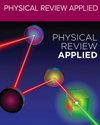Experimental demonstration of deep-learning-enabled adaptive optics
IF 4.4
2区 物理与天体物理
Q2 PHYSICS, APPLIED
引用次数: 0
Abstract
Satellite-based quantum communication is a promising approach for establishing global-scale quantum networks. In free-space quantum channels, single-mode-fiber coupling plays a crucial role in increasing the signal-to-noise ratio of daylight quantum key distribution (QKD) and ensuring compatibility with standard fiber-based QKD protocols. However, consistently achieving high efficiency and stable single-mode-fiber coupling under strong atmospheric turbulence remains an ongoing experimental challenge. In this study, we experimentally demonstrate an adaptive method based on convolutional neural networks capable of directly estimating phase information from a single defocused image. We developed a convolutional neural network to establish the relationship between intensity distribution and phase information of turbulent distortions. We demonstrate the real-time performance of our deep-learning adaptive method in increasing single-mode-fiber coupling efficiency across various turbulence scales and quantify turbulence frequencies. Notably, the method proved highly effective in strong-turbulence scenarios, with frequencies reaching up to 200 Hz, leading to a significant increase in single-mode-fiber coupling efficiency. We demonstrate the corrective capability of our adaptive method for strong turbulence, enabled by the generalization of the convolutional neural network. Our results offer an efficient solution for daytime free-space QKD applications.

深度学习自适应光学实验演示
基于卫星的量子通信是建立全球规模量子网络的一种前景广阔的方法。在自由空间量子信道中,单模光纤耦合在提高日光量子密钥分发(QKD)的信噪比和确保与基于光纤的标准 QKD 协议兼容方面发挥着至关重要的作用。然而,在强大气湍流条件下持续实现高效稳定的单模光纤耦合仍然是一项持续的实验挑战。在本研究中,我们通过实验演示了一种基于卷积神经网络的自适应方法,该方法能够直接从单个散焦图像中估算相位信息。我们开发了一种卷积神经网络来建立湍流变形的强度分布和相位信息之间的关系。我们展示了深度学习自适应方法在提高各种湍流尺度的单模光纤耦合效率和量化湍流频率方面的实时性能。值得注意的是,该方法在强湍流情况下非常有效,频率高达 200 Hz,从而显著提高了单模光纤耦合效率。通过卷积神经网络的泛化,我们证明了自适应方法对强湍流的修正能力。我们的成果为日间自由空间 QKD 应用提供了高效的解决方案。
本文章由计算机程序翻译,如有差异,请以英文原文为准。
求助全文
约1分钟内获得全文
求助全文
来源期刊

Physical Review Applied
PHYSICS, APPLIED-
CiteScore
7.80
自引率
8.70%
发文量
760
审稿时长
2.5 months
期刊介绍:
Physical Review Applied (PRApplied) publishes high-quality papers that bridge the gap between engineering and physics, and between current and future technologies. PRApplied welcomes papers from both the engineering and physics communities, in academia and industry.
PRApplied focuses on topics including:
Biophysics, bioelectronics, and biomedical engineering,
Device physics,
Electronics,
Technology to harvest, store, and transmit energy, focusing on renewable energy technologies,
Geophysics and space science,
Industrial physics,
Magnetism and spintronics,
Metamaterials,
Microfluidics,
Nonlinear dynamics and pattern formation in natural or manufactured systems,
Nanoscience and nanotechnology,
Optics, optoelectronics, photonics, and photonic devices,
Quantum information processing, both algorithms and hardware,
Soft matter physics, including granular and complex fluids and active matter.
 求助内容:
求助内容: 应助结果提醒方式:
应助结果提醒方式:


